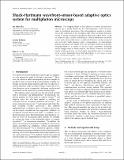Shack-Hartmann wavefront-sensor-based adaptive optics system for microscopy
Author(s)
So, Peter T. C.; Cha, Jae Won; Ballesta, Jerome
DownloadCha-2010-Shack-Hartmann wavef.pdf (1.109Mb)
PUBLISHER_POLICY
Publisher Policy
Article is made available in accordance with the publisher's policy and may be subject to US copyright law. Please refer to the publisher's site for terms of use.
Terms of use
Metadata
Show full item recordAbstract
The imaging depth of two-photon excitation fluorescence microscopy is partly limited by the inhomogeneity of the refractive index in biological specimens. This inhomogeneity results in a distortion of the wavefront of the excitation light. This wavefront distortion results in image resolution degradation and lower signal level. Using an adaptive optics system consisting of a Shack-Hartmann wavefront sensor and a deformable mirror, wavefront distortion can be measured and corrected. With adaptive optics compensation, we demonstrate that the resolution and signal level can be better preserved at greater imaging depth in a variety of ex-vivo tissue specimens including mouse tongue muscle, heart muscle, and brain. However, for these highly scattering tissues, we find signal degradation due to scattering to be a more dominant factor than aberration.
Date issued
2010-08Department
Massachusetts Institute of Technology. Department of Biological Engineering; Massachusetts Institute of Technology. Department of Mechanical EngineeringJournal
Journal of Biomedical Optics
Publisher
SPIE (Society)
Citation
Cha, Jae Won, Jerome Ballesta, and Peter T. C. So. “Shack-Hartmann wavefront-sensor-based adaptive optics system for multiphoton microscopy.” Journal of Biomedical Optics 15.4 (2010): 046022. © 2010 Society of Photo-Optical Instrumentation Engineers SPIE
Version: Final published version
ISSN
1083-3668